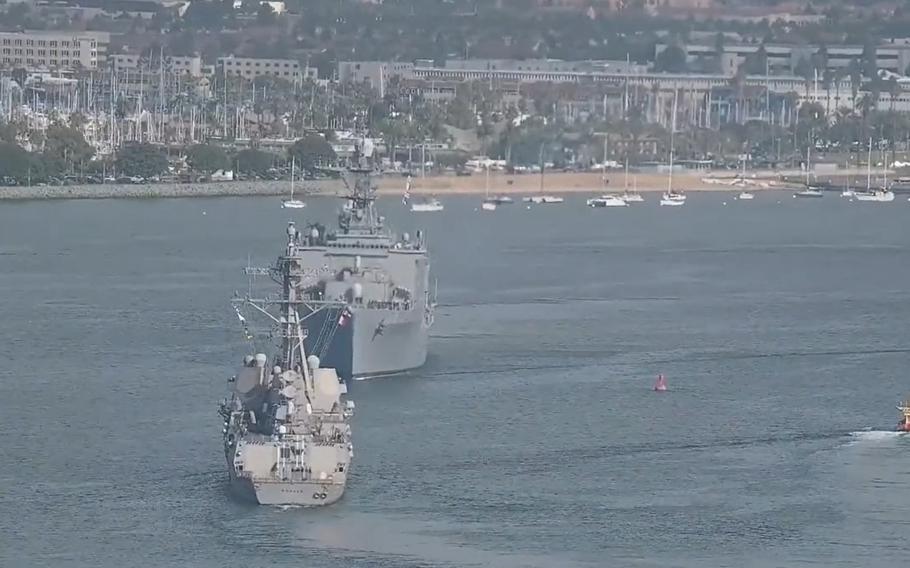
The USS Momsen, a guided-missile destroyer, and USS Harpers Ferry, a dock-landing ship, were moving in opposite directions in San Diego Bay on Tuesday, Nov. 29, 2022, when they came close to colliding, service officials said. (Screengrab from Twitter)
SAN DIEGO (Tribune News Service) — The near-collision of two Navy warships in San Diego Bay in November was a preventable incident caused by numerous failures, including poor communication on and between the vessels, according to an investigation by the Navy.
The partially redacted report also says that evasive action taken by junior officers enabled the guided-missile destroyer Momsen and the dock landing ship Harpers Ferry to avoid crashing into one another in the narrowest part of the harbor.
The bay is home to more than 50 Navy ships, including two aircraft carriers, making it the largest naval installation on the West Coast and one of the largest in the world.
If Momsen and Harpers Ferry had collided, it might have tied up the main channel of the harbor. But the ships made sharp, last-minute turns, slipping past each other, leading the Navy to decide against taking punitive action.
“This preliminary inquiry is an opportunity to critically assess processes and implement lessons learned to ensure this type of incident does not occur again,” Vice Adm. Roy Kitchener, commander of Naval Surface Force, U.S. Pacific Fleet, said in the report.
The investigation was completed months ago. But it only became public last week when it was published by the U.S. Naval Institute, an independent interest group based in Annapolis, Md.
The report focuses on two of the most valuable types of ships operated by the Navy.
The Momsen is a 510-foot Arleigh Burke-class destroyer that’s used to help protect aircraft carrier groups and is capable of launching long-range Tomahawk cruise missiles.
Harpers Ferry is a 610-foot, first-of-her-class dock landing ship that supports amphibious operations and is capable of carrying upwards of 500 Marines as well as landing craft.
At the time of the incident, the Momsen was entering the harbor and Harpers Ferry was leaving. They started to enter a collision course as Harpers Ferry was rounding Naval Air Station North Island near Shelter Island.
The ships were “projected to meet in the most dangerous portion of the San Diego harbor narrow channel, an area San Diego pilots call the Triangle, where pilots attempt to avoid meeting situations,” says the report, whose redactions make it impossible to know precisely what happened.
Investigators also determined that there was “disagreement and confusion on the (Harpers Ferry) bridge” about where Momsen was headed, and that Momsen’s crew wasn’t aware of the problem.
The report indicates that the confusion deepened on both ships, leading to communications problems. The situation was compounded by a small electrical fire that broke out on Harpers Ferry, which affected its navigation system.
A collision was avoided when both ships, at roughly the same time, took evasive action, making sharp turns. Both ships announced that they were turning to port to get around each other, according to radio traffic.
Junior officers aboard Harpers Ferry played especially key roles in preventing an accident, the report says.
The incident was visible from land and was magnified by SanDiegoWebCam, a website that operates cameras that provide live coverage of boating activity in San Diego Bay.
The website, which is used by everyone from the Coast Guard to ship enthusiasts, captured audio and video of the near collision, which quickly went viral on social media. Soon, people were calling the incident “warship chicken.”
The video was taken by the company’s cameras on Cabrillo National Monument, which is part of the National Park Service.
Shortly before the investigatory report was released, the park service took those cameras offline, according to Barry Bahrami, who operates SanDiegoWebCam. The action was taken even though he had permission to use the park site.
A Navy spokesperson said that the Navy did not request that such action be taken. A park service email reviewed by the Union-Tribune indicates that the decision was not made by officials at Cabrillo but by officials higher in the park service. The email also thanks Bahrami for partnering with the park service to provide internet service at Cabrillo.
“I was told the cameras were turned off for force protection, which is absurd,” said Bahrami. “Those cameras have been up there for 10 years and are used by everybody.”
©2023 The San Diego Union-Tribune.
Visit sandiegouniontribune.com.
Distributed by Tribune Content Agency, LLC.